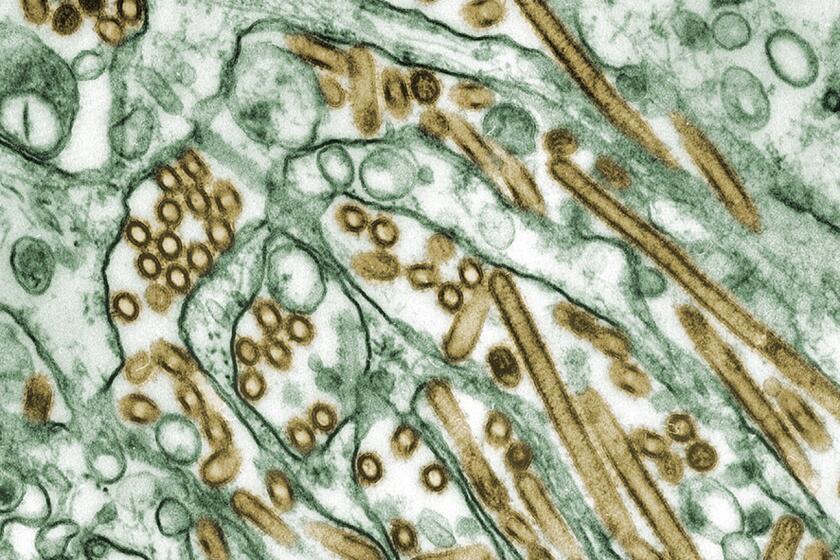Animal Activist Finds Himself in Rat’s Nest of Legal Trouble
Rob Puddicombe figured he was annoying the National Park Service, but he didn’t think officials would make a federal case out of it.
That miscalculation could now mean a year in prison for him. The charge -- feeding vitamins to rats.
“These people hate me,” Puddicombe said. “And they want to keep me off the islands.”
A bus driver and environmental activist from Santa Barbara, Puddicombe is an uncommon crusader with an unusual obsession -- saving the black rats of the Channel Islands. He is accused of sailing a 10-foot inflatable boat last year across the channel to Anacapa Island, which actually is three small islands, to distribute pellets containing vitamin K to the rat population.
Park service rangers have been feeding the rats something very different -- rodent poison -- and they say the vitamin K distribution was designed to counteract the extermination effort. Puddicombe was charged with illegally feeding animals and interfering with agency functions. His trial is scheduled for Feb. 20.
At issue are two starkly opposed views of the proper relationship between people and animals -- or at least man and rat.
“We have a case here of someone trying to circumvent the efforts of scientists to eradicate what they have determined to be an environmental pest,” said Thom Mrozek, spokesman for the U.S. attorney’s office in Los Angeles. “A lot of time and effort went into this project, and he is accused of trying to undo what they started. He is interfering.”
Park officials say they need to get rid of the rats, which are not native to the islands, to protect several native species, particularly a small seabird called the Xantus’s murrelet, whose eggs the rodents devour.
“The Channel Islands are a special place because they provide a haven for creatures that appear nowhere else,” said Kate Faulkner, chief of natural resources management at Channel Islands National Park. “There are lots of places for rats, and not many for murrelets.”
Puddicombe believes that park rangers have no right to choose which animals should live and which should die.
“It’s a topsy-turvy world when poisoning wildlife from helicopters is a good thing and feeding wildlife is a crime,” he said. “As far as I’m concerned, this is like ethnic cleansing; it’s a jihad against nonnative species.”
“I love underdogs, and rodents are the underdogs of the animal kingdom,” he added. “A mouse or rat is just as valuable as an elephant. It’s just as smart and has the same feelings.”
The dispute echoes similar controversies that have dogged campaigns to eliminate predators, from seagulls to snakes, that threaten native species in isolated ecosystems such as those on islands. In the case of the Channel Islands, park service officials are in the middle of a complex ecological juggling act, trying to remove rats, pigs and golden eagles to restore the five-island park to its original condition.
No one knows when the first rat scurried onto the islands. Some say the rodents arrived after the paddle steamer Winfield Scott ran aground between Middle and East Anacapa islands in 1853. Others say the first rat presence was recorded in 1939.
On Anacapa the numbers of the rodents, which are native to Europe and grow to about 14 inches long, have ranged up to an estimated 3,000. (The rats also live on San Miguel Island, but are not considered a problem there and have not been poisoned.)
“They eat smaller eggs, and they will eat newly hatched chicks,” said Paul Collins, curator of vertebrate zoology at the Santa Barbara Museum of Natural History, who has studied the rats.
Among the eggs the rats like to munch are those of the petite, black and white Xantus’s murrelet, which nests only on Santa Barbara and Anacapa islands and is a candidate for listing as a threatened species, officials say.
Puddicombe, 52, doesn’t buy it. He says the $2-million rat project is an example of the park service’s demonizing, and then annihilating, an animal to return the islands to some murky, idealized past.
“How far do they want to go back? To the Chumash? The pre-Chumash? The Cretaceous era?” he asked, sitting on a patch of beach near Ventura that he likes to call his “office.”
Quiet, informed and intense, Puddicombe is an Eagle Scout who grew up in a military family and moved around the country before landing in Santa Barbara.
He worked as a diver on offshore oil platforms in the North Sea and the Gulf of Mexico. Later he dove for abalone off Santa Barbara and volunteered as a seabird rehabilitator.
“Rob is a very sensitive guy who hates to see animals suffer,” said June Taylor, who runs a seabird rescue center in Santa Barbara and has 18 pelicans in her backyard pond. “He rescues seabirds and brings them to me. I am not really surprised to hear about the rats. He meant well.”
Indeed, Puddicombe was aghast at the extermination plan. “When I heard they were dropping poison I got involved,” he said, gazing out at Anacapa, finely etched against the blue horizon. “There is something for everyone to hate about this project.”
Critics say the poison intended to kill rats is also killing the Anacapa deer mouse, a species found only on the island. They also maintain that there is no evidence the rat has damaged the murrelet population.
“We feel these charges against Mr. Puddicombe are clearly retaliatory,” said Michael Makarian, president of the New York-based Fund for Animals. “The agency is upset that anyone has expressed dissent over their plans to bomb an entire ecosystem with poison.” The group recently joined with Puddicombe in asking the government to declare the Anacapa deer mouse an endangered species and stop the poisoning.
The park service said hundreds of deer mice were taken off the island before the extermination campaign and are being reintroduced as the poisoning is finished. And they say they have videos of rats munching decoy eggs.
Puddicombe spent a year successfully filing Freedom of Information Act requests seeking memos, e-mails and reports from government agencies and companies involved in the poisoning. He formed the Channel Islands Animal Protection Assn. last year as a self-appointed guardian of island creatures.
The group sued the park service last year to try to stop the poisoning, but the case was thrown out by a federal court in Washington, D.C.
“He did a spectacular piece of research in tracking down the details of this project,” said Ken Palley, president of the Santa Barbara Surfrider Foundation, which opposes the extermination. “Rob is a reasonable guy. He’s no loose cannon. It’s like when Mahatma Gandhi and Martin Luther King went up against government agencies -- he put his body on the line.”
Puddicombe decided to act in October of last year. Prosecutors said he sailed an inflatable boat 11 miles across the Santa Barbara Channel to Anacapa and fed rats food laced with vitamin K. The poison the park service uses prevents blood from clotting, effectively causing rats to bleed to death internally. The vitamin interferes with that process. Puddicombe said he won’t comment on the incident until his trial.
Park rangers saw Puddicombe and a second man identified as 40-year-old Robert Crawford of Goleta wearing large backpacks and sitting on a trail, throwing something, said Mrozek of the U.S. attorney’s office.
Suspicious park staff members smelled a rat and later found nearly 5 pounds of vitamin pellets scattered over the island. By then, the two men were back in the boat and trying to get underway.
“But the boat broke down,” Mrozek said.
As the men waited for help, rangers concluded that they were connected to the pellets. Both were cited with misdemeanor offenses.
Crawford pleaded guilty to feeding wildlife and interfering with agency functions. He was sentenced to two years’ probation, told to keep off the islands for two years and ordered to pay $200 in restitution, Mrozek said.
Puddicombe refused to deal and insisted on a trial, hoping that the public would be as outraged as he was over the rat killing.
But his efforts may have been in vain. Park service officials have finished dropping poison. By the time the trial starts, they estimate, the rats will have been eradicated.
Puddicombe shook his head. “This,” he said, “is barbaric.”
More to Read
Start your day right
Sign up for Essential California for news, features and recommendations from the L.A. Times and beyond in your inbox six days a week.
You may occasionally receive promotional content from the Los Angeles Times.






